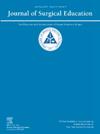综合整形申请者叙事性和标准化推荐信的语言分析及其对匹配的影响
IF 2.1
3区 医学
Q1 EDUCATION, SCIENTIFIC DISCIPLINES
引用次数: 0
摘要
目的应用于综合整形重建手术(PRS)的竞争日益激烈,推荐信在其中起着匹配作用。本研究评估了综合整形手术申请人的叙述和标准化字母,以确定哪些字母成分最能预测匹配。设计语言分析采用语言调查和单词计数软件,使用定制词典对所有叙述信件进行分析。作者、作者专业等级和申请人排名从标准化信件中收集。统计学分析,p <; 0.05为显著性。这是一项单机构研究。参与者本研究包括2023年至2024年周期内我院所有综合整形手术申请人。结果共纳入304名申请人,共1124名叙述性LOR。匹配的申请人具有显著更高的叙述性LOR数量(3.77个字母对3.54个字母,p < 0.001)。匹配的申请人LORs在包括研究、磨砺和亲和力在内的几个有利类别上的计数明显更高。与其他专业相比,拥有整形外科医生证明的申请人匹配的几率要高得多(OR 7.89, p < 0.001)。大约有380封标准化信件可供分析。匹配的申请人有更标准化的推荐信(1.52封信对0.79封信,p < 0.001)。与匹配相关的重要因素包括患者护理、专业精神和团队合作精神。总排名1和2至5与更大的匹配几率相关(OR 3.94, p <; 0.001和OR 1.8, p = 0.02),而排名5至10和10至20与匹配负相关(OR 0.55, p = 0.03和OR 0.07 p = 0.01)。结论本研究综合分析了综合PRS申请人的叙事性和标准化的LOR。在匹配的申请信中使用的最受欢迎的域名是研究、磨砺、讨人喜欢和突出。匹配的申请人总体排名较高,而总体排名较差的申请人匹配的几率明显较低。这项研究可能为成功匹配提供信息。本文章由计算机程序翻译,如有差异,请以英文原文为准。
Linguistic Analysis of Narrative and Standardized Letters of Recommendation for Integrated Plastic Surgery Applicants and Impact on Match
OBJECTIVE
Applying to integrated plastic and reconstructive surgery (PRS) has become increasingly competitive and letters of recommendations play a role in matching. This study evaluates narrative and standardized letters for integrated plastic surgery applicants to determine which letter components are most predictive of matching.
DESIGN
Linguistic analysis was performed on all narrative letters with Linguistic Inquiry and Word Count software using a customized dictionary. LOR authors, author professional rank, and applicant rankings were collected from standardized letters. Statistical analysis was performed with significance set to p < 0.05.
SETTING
This is a single-institution study.
PARTICIPANTS
This study included all integrated plastic surgery applicants to our institution in the 2023 to 2024 cycle.
RESULTS
About 304 applicants were included with 1124 total narrative LOR. Matched applicants had significantly higher numbers of narrative LOR (3.77 letters vs. 3.54 letters, p < 0.001). Matched applicant LORs had significantly higher counts across several favorable categories including research, grindstone, and likability. Applicants with letters by plastic surgeons versus other specialties had significantly higher odds of matching (OR 7.89, p < 0.001). About 380 standardized letters were available for analysis. Matched applicants had significantly more standardized letters of recommendation (1.52 letters vs. 0.79 letters, p < 0.001). Important factors associated with matching included patient care, professionalism, and team-player. An overall rank of 1 and 2 to 5 was associated with greater odds of matching (OR 3.94, p < 0.001 and OR 1.8, p = 0.02, respectively), while ranking 5 to 10 and 10 to 20 were negatively associated with matching (OR 0.55, p = 0.03 and OR 0.07 p = 0.01, respectively).
CONCLUSION
This study comprehensively analyzes narrative and standardized LOR for integrated PRS applicants. Top favorable domains used in matched applicant letters were research, grindstone, likability, and standout. Matched applicants were ranked higher overall, and worse overall rankings had significantly lower odds of matching. This study may inform success in matching.
求助全文
通过发布文献求助,成功后即可免费获取论文全文。
去求助
来源期刊

Journal of Surgical Education
EDUCATION, SCIENTIFIC DISCIPLINES-SURGERY
CiteScore
5.60
自引率
10.30%
发文量
261
审稿时长
48 days
期刊介绍:
The Journal of Surgical Education (JSE) is dedicated to advancing the field of surgical education through original research. The journal publishes research articles in all surgical disciplines on topics relative to the education of surgical students, residents, and fellows, as well as practicing surgeons. Our readers look to JSE for timely, innovative research findings from the international surgical education community. As the official journal of the Association of Program Directors in Surgery (APDS), JSE publishes the proceedings of the annual APDS meeting held during Surgery Education Week.
 求助内容:
求助内容: 应助结果提醒方式:
应助结果提醒方式:


